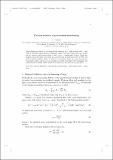Files in this item
The new frontiers of gravitational microlensing
Item metadata
| dc.contributor.author | Dominik, M. | |
| dc.date.accessioned | 2022-05-13T11:30:14Z | |
| dc.date.available | 2022-05-13T11:30:14Z | |
| dc.date.issued | 2022-08 | |
| dc.identifier | 279547802 | |
| dc.identifier | 76b38423-b258-4822-8eb3-d28409eb5909 | |
| dc.identifier | 85129902592 | |
| dc.identifier | 000848888100001 | |
| dc.identifier.citation | Dominik , M 2022 , ' The new frontiers of gravitational microlensing ' , International Journal of Modern Physics D , vol. 31 , no. 11 , 2240009 . https://doi.org/10.1142/s0218271822400090 | en |
| dc.identifier.issn | 0218-2718 | |
| dc.identifier.other | Jisc: 299928 | |
| dc.identifier.other | ORCID: /0000-0002-3202-0343/work/113060933 | |
| dc.identifier.uri | https://hdl.handle.net/10023/25366 | |
| dc.description.abstract | Albert Einstein referred to gravitational microlensing as a “most curious effect”, and while its underlying principles are intriguingly simple, their universality makes a powerful tool for inferring information about a wide range of astronomical bodies. Much has happened since the first observation of a gravitational microlensing event in 1992, and the frontiers have shifted. What we did not dare dreaming about just a few decades ago turned into reality, and we have not reached the end of the journey. New challenges and opportunities lie ahead. Where might we be able to go and how can we get there? | |
| dc.format.extent | 917974 | |
| dc.language.iso | eng | |
| dc.relation.ispartof | International Journal of Modern Physics D | en |
| dc.subject | General relativity | en |
| dc.subject | Gravitational microlensing | en |
| dc.subject | Extra-solar planets | en |
| dc.subject | Black holes | en |
| dc.subject | QC Physics | en |
| dc.subject | T-NDAS | en |
| dc.subject | AC | en |
| dc.subject.lcc | QC | en |
| dc.title | The new frontiers of gravitational microlensing | en |
| dc.type | Journal article | en |
| dc.contributor.institution | University of St Andrews. St Andrews Centre for Exoplanet Science | en |
| dc.contributor.institution | University of St Andrews. School of Physics and Astronomy | en |
| dc.identifier.doi | https://doi.org/10.1142/s0218271822400090 | |
| dc.description.status | Peer reviewed | en |
This item appears in the following Collection(s)
Items in the St Andrews Research Repository are protected by copyright, with all rights reserved, unless otherwise indicated.

